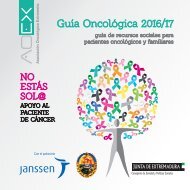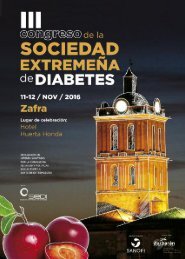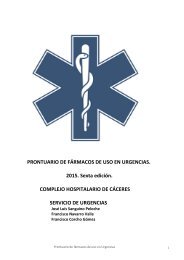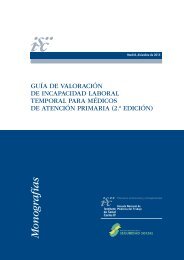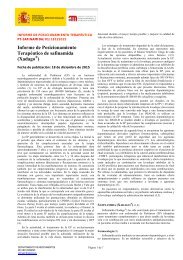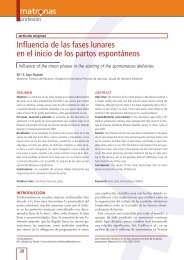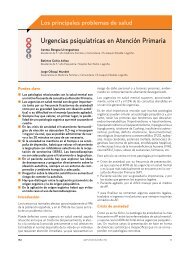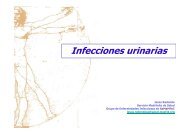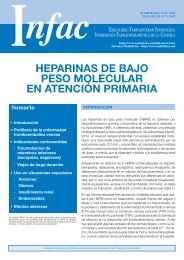ATYs306Q6fE
ATYs306Q6fE
ATYs306Q6fE
Create successful ePaper yourself
Turn your PDF publications into a flip-book with our unique Google optimized e-Paper software.
81<br />
conditions: a nested case control study. J Cardiovasc Electrophysiol. 2009;20:<br />
401–7.<br />
849. Moss AJ, Zareba W, Benhorin J, Locati EH, Hall WJ, Robinson JL, Schwartz PJ,<br />
Towbin JA, Vincent GM, Lehmann MH. ECG T-wave patterns in genetically<br />
distinct forms of the hereditary long QT syndrome. Circulation. 1995;92:<br />
2929–34.<br />
850. Schwartz PJ, Priori SG, Spazzolini C, Moss AJ, Vincent GM, Napolitano C, Denjoy I,<br />
Guicheney P, Breithardt G, Keating MT, Towbin JA, Beggs AH, Brink P, Wilde AA,<br />
Toivonen L, Zareba W, Robinson JL, Timothy KW, Corfield V, Wattanasirichaigoon<br />
D, Corbett C, Haverkamp W, Schulze-Bahr E, Lehmann MH, Schwartz K, Coumel<br />
P, Bloise R. Genotype-phenotype correlation in the long-QT syndrome: genespecific<br />
triggers for life-threatening arrhythmias. Circulation. 2001;103:89–95.<br />
851. Eckardt L, Kirchhof P, Loh P, Schulze-Bahr E, Johna R, Wichter T, Breithardt G,<br />
Haverkamp W, Borggrefe M. Brugada syndrome and supraventricular<br />
tachyarrhythmias: a novel association? J Cardiovasc Electrophysiol. 2001;12:<br />
680–5.<br />
852. Kaufman ES. Mechanisms and clinical management of inherited channelopathies:<br />
long QT syndrome, Brugada syndrome, catecholaminergic polymorphic<br />
ventricular tachycardia, and short QT syndrome. Heart Rhythm. 2009;6:S51–5.<br />
853. Antzelevitch C, Pollevick GD, Cordeiro JM, Casis O, Sanguinetti MC, Aizawa Y,<br />
Guerchicoff A, Pfeiffer R, Oliva A, Wollnik B, Gelber P, Bonaros EP Jr, Burashnikov<br />
E, Wu Y, Sargent JD, Schickel S, Oberheiden R, Bhatia A, Hsu LF, Haissaguerre M,<br />
Schimpf R, Borggrefe M,Wolpert C. Loss-of-function mutations in the cardiac<br />
calcium channel underlie a new clinical entity characterized by ST-segment<br />
elevation, short QT intervals, and sudden cardiac death. Circulation. 2007;115:<br />
442–9.<br />
854. London B, Michalec M, Mehdi H, Zhu X, Kerchner L, Sanyal S, Viswanathan PC,<br />
Pfahnl AE, Shang LL, Madhusudanan M, Baty CJ, Lagana S, Aleong R, Gutmann R,<br />
Ackerman MJ, McNamara DM, Weiss R, Dudley SC Jr. Mutation in glycerol-3-<br />
phosphate dehydrogenase 1 like gene (GPD1-L) decreases cardiac Na+ current<br />
and causes inherited arrhythmias. Circulation. 2007;116:2260–8.<br />
855. Watanabe H, Koopmann TT, Le Scouarnec S, Yang T, Ingram CR, Schott JJ,<br />
Demolombe S, Probst V, Anselme F, Escande D, Wiesfeld AC, Pfeufer A, Kaab S,<br />
Wichmann HE, Hasdemir C, Aizawa Y, Wilde AA, Roden DM, Bezzina CR. Sodium<br />
channel beta1 subunit mutations associated with Brugada syndrome and cardiac<br />
conduction disease in humans. J Clin Invest.2008;118:2260–8.<br />
856. Brugada R, Hong K, Dumaine R, Cordeiro J, Gaita F, Borggrefe M, Menendez TM,<br />
Brugada J, Pollevick GD, Wolpert C, Burashnikov E, Matsuo K, Wu YS, Guerchicoff<br />
A, Bianchi F, Giustetto C, Schimpf R, Brugada P, Antzelevitch C. Sudden death<br />
associated with short-QT syndrome linked to mutations in HERG. Circulation.<br />
2004;109:30–5.<br />
857. Gaita F, Giustetto C, Bianchi F, Wolpert C, Schimpf R, Riccardi R, Grossi S, Richiardi<br />
E, Borggrefe M. Short QT Syndrome: a familial cause of sudden death. Circulation.<br />
2003;108:965–70.<br />
858. Giustetto C, Di Monte F,Wolpert C, Borggrefe M, Schimpf R, Sbragia P, Leone G,<br />
Maury P, Anttonen O, Haissaguerre M, Gaita F. Short QT syndrome: clinical<br />
findings and diagnostic-therapeutic implications. Eur Heart J. 2006;27:2440–7.<br />
859. Bhuiyan ZA, van den Berg MP, van Tintelen JP, Bink-Boelkens MT, Wiesfeld AC,<br />
Alders M, Postma AV, van Langen I, Mannens MM, Wilde AA. Expanding spectrum<br />
of human RYR2-related disease: new electrocardiographic, structural, and<br />
genetic features. Circulation. 2007;116:1569–76.<br />
860. Napolitano C, Priori SG. Diagnosis and treatment of catecholaminergic<br />
polymorphic ventricular tachycardia. Heart Rhythm. 2007;4:675–8.<br />
861. Mohamed U, Napolitano C, Priori SG. Molecular and electrophysiological bases of<br />
catecholaminergic polymorphic ventricular tachycardia. J Cardiovasc<br />
Electrophysiol. 2007;18:791–7.<br />
862. Lee CH, Liu PY, Lin LJ, Chen JH, Tsai LM. Clinical characteristics and outcomes of<br />
hypertrophic cardiomyopathy in Taiwan—a tertiary center experience. Clin<br />
Cardiol. 2007;30:177–82.<br />
863. Losi MA, Betocchi S, Aversa M, Lombardi R, Miranda M, D’Alessandro G, Cacace A,<br />
Tocchetti CG, Barbati G, Chiariello M. Determinants of atrial fibrillation<br />
development in patients with hypertrophic cardiomyopathy. Am J Cardiol.<br />
2004;94:895–900.<br />
864. Maron BJ, Olivotto I, Bellone P, Conte MR, Cecchi F, Flygenring BP, Casey SA,<br />
Gohman TE, Bongioanni S, Spirito P. Clinical profile of stroke in 900 patients with<br />
hypertrophic cardiomyopathy. J Am Coll Cardiol 2002;39:301–7.<br />
865. Gollob MH, Seger JJ, Gollob TN, Tapscott T, Gonzales O, Bachinski L, Roberts R.<br />
Novel PRKAG2 mutation responsible for the genetic syndrome of ventricular<br />
preexcitation and conduction system disease with childhood onset and absence<br />
of cardiac hypertrophy. Circulation. 2001;104:3030–3.<br />
866. Postma AV, van de Meerakker JB, Mathijssen IB, Barnett P, Christoffels VM, Ilgun<br />
A, Lam J, Wilde AA, Lekanne Deprez RH, Moorman AF. A gain-of-function TBX5<br />
mutation is associated with atypical Holt-Oram syndrome and paroxysmal atrial<br />
fibrillation. Circ Res. 2008;102:1433–42.<br />
867. Marcus FI, Edson S, Towbin JA. Genetics of arrhythmogenic right ventricular<br />
cardiomyopathy: a practical guide for physicians. J Am Coll Cardiol. 2013;61:<br />
1945–8.<br />
868. Chu AF, Zado E, Marchlinski FE. Atrial arrhythmias in patients with arrhythmogenic<br />
right ventricular cardiomyopathy/dysplasia and ventricular tachycardia. Am J<br />
Cardiol. 2010;106:720–2.<br />
869. Blomstrom-Lundqvist C, Scheinman MM, Aliot EM, Alpert JS, Calkins H, Camm AJ,<br />
Campbell WB, Haines DE, Kuck KH, Lerman BB, Miller DD, Shaeffer CW, Stevenson<br />
WG, Tomaselli GF, Antman EM, Smith SC Jr, Alpert JS, Faxon DP, Fuster V, Gibbons<br />
RJ, Gregoratos G, Hiratzka LF, Hunt SA, Jacobs AK, Russell RO Jr, Priori SG, Blanc JJ,<br />
Budaj A, Burgos EF, Cowie M, Deckers JW, Garcia MA, Klein WW, Lekakis J, Lindahl<br />
B, Mazzotta G, Morais JC, Oto A, Smiseth O, Trappe HJ, European Society of<br />
Cardiology Committee, NASPE-Heart Rhythm Society. ACC/AHA/ESC guidelines<br />
for the management of patients with supraventricular arrhythmias—executive<br />
summary. a report of the American college of cardiology/American heart<br />
association task force on practice guidelines and the European society of<br />
cardiology committee for practice guidelines (writing committee to develop<br />
guidelines for the management of patients with supraventricular arrhythmias)<br />
developed in collaboration with NASPE-Heart Rhythm Society. J Am Coll Cardiol.<br />
2003;42:1493–531.<br />
870. Tischenko A, Fox DJ, Yee R, Krahn AD, Skanes AC, Gula LJ, Klein GJ. When should<br />
we recommend catheter ablation for patients with the Wolff-Parkinson-White<br />
syndrome? Curr Opin Cardiol. 2008;23:32–7.<br />
871. Kibos A, Deharo JC, Adoubi A, Assouan X, Djianeb P. [Clinical and<br />
electrophysiological study of asymptomaticWolff-Parkinson-White syndrome].<br />
Ann Cardiol Angeiol (Paris). 2007;56:237–40.<br />
872. Pappone C, Santinelli V, Manguso F, Augello G, Santinelli O, Vicedomini G,<br />
Gulletta S, Mazzone P, Tortoriello V, Pappone A, Dicandia C, Rosanio S. A<br />
randomized study of prophylactic catheter ablation in asymptomatic patients<br />
with the Wolff-Parkinson-White syndrome. N Engl J Med. 2003;349:1803–11.<br />
873. Boahene KA, Klein GJ, Yee R, Sharma AD, Fujimura O. Termination of acute atrial<br />
fibrillation in the Wolff-Parkinson-White syndrome by procainamide and<br />
propafenone: importance of atrial fibrillatory cycle length. J Am Coll Cardiol.<br />
1990;16:1408–14.<br />
874. O’Nunain S, Garratt CJ, Linker NJ, Gill J, Ward DE, Camm AJ. A comparison of<br />
intravenous propafenone and flecainide in the treatment of tachycardias<br />
associated with the Wolff-Parkinson-White syndrome. Pacing Clin Electrophysiol.<br />
1991;14:2028–34.<br />
875. Manolis AS, Estes NA III. Supraventricular tachycardia. Mechanisms and therapy.<br />
Arch Intern Med. 1987;147:1706–16.<br />
876. Simonian SM, Lotfipour S, Wall C, Langdorf MI. Challenging the superiority of<br />
amiodarone for rate control in Wolff-Parkinson-White and atrial fibrillation.<br />
Intern Emerg Med. 2010;5:421–6.<br />
877. Guttmann OP, Rahman MS, O’Mahony C, Anastasakis A, Elliott PM. Atrial<br />
fibrillation and thromboembolism in patients with hypertrophic cardiomyopathy:<br />
systematic review. Heart. 2014;100:465–72.<br />
878. Olivotto I, Cecchi F, Casey SA, Dolara A, Traverse JH, Maron BJ. Impact of atrial<br />
fibrillation on the clinical course of hypertrophic cardiomyopathy. Circulation.<br />
2001;104:2517–24.<br />
879. Cecchi F, Olivotto I, Montereggi A, Squillatini G, Dolara A, Maron BJ. Prognostic<br />
value of non-sustained ventricular tachycardia and the potential role of<br />
amiodarone treatment in hypertrophic cardiomyopathy: assessment in an<br />
unselected nonreferral based patient population. Heart. 1998;79:331–6.<br />
880. Bunch TJ, Munger TM, Friedman PA, Asirvatham SJ, Brady PA, Cha YM, Rea RF,<br />
Shen WK, Powell BD, Ommen SR, Monahan KH, Haroldson JM, Packer DL.<br />
Substrate and procedural predictors of outcomes after catheter ablation for atrial<br />
fibrillation in patients with hypertrophic cardiomyopathy. J Cardiovasc<br />
Electrophysiol. 2008;19:1009–14.<br />
881. Di Donna P, Olivotto I, Delcre SD, Caponi D, Scaglione M, Nault I, Montefusco A,<br />
Girolami F, Cecchi F, Haissaguerre M, Gaita F. Efficacy of catheter ablation for<br />
atrial fibrillation in hypertrophic cardiomyopathy: impact of age, atrial<br />
remodelling, and disease progression. Europace. 2010;12:347–55.<br />
882. Gaita F, Di Donna P, Olivotto I, Scaglione M, Ferrero I, Montefusco A, Caponi D,<br />
Conte MR, Nistri S, Cecchi F. Usefulness and safety of transcatheter ablation of<br />
atrial fibrillation in patients with hypertrophic cardiomyopathy. Am J Cardiol.<br />
2007;99:1575–81.<br />
883. Kilicaslan F, Verma A, Saad E, Themistoclakis S, Bonso A, Raviele A, Bozbas H,<br />
Andrews MW, Beheiry S, Hao S, Cummings JE, Marrouche NF, Lakkireddy D,<br />
Wazni O, Yamaji H, Saenz LC, SalibaW, Schweikert RA, Natale A. Efficacy of<br />
catheter ablation of atrial fibrillation in patients with hypertrophic obstructive<br />
cardiomyopathy. Heart Rhythm. 2006;3:275–80.<br />
884. McCready JW, Smedley T, Lambiase PD, Ahsan SY, Segal OR, Rowland E, Lowe MD,<br />
Chow AW. Predictors of recurrence following radiofrequency ablation for<br />
persistent atrial fibrillation. Europace. 2011;13:355–61.<br />
885. Ritchie MD, Rowan S, Kucera G, Stubblefield T, Blair M, Carter S, Roden DM,<br />
Darbar D. Chromosome 4q25 variants are genetic modifiers of rare ion channel<br />
mutations associated with familial atrial fibrillation. J Am Coll Cardiol.<br />
2012;60:1173–81.<br />
886. Mann SA, Otway R, Guo G, Soka M, Karlsdotter L, Trivedi G, Ohanian M, Zodgekar<br />
P, Smith RA, Wouters MA, Subbiah R, Walker B, Kuchar D, Sanders P, Griffiths L,<br />
Vandenberg JI, Fatkin D. Epistatic effects of potassium channel variation on<br />
cardiac repolarization and atrial fibrillation risk. J Am Coll Cardiol. 2012;59:<br />
1017–25.<br />
887. Giustetto C, Cerrato N, Gribaudo E, Scrocco C, Castagno D, Richiardi E, Giachino D,<br />
Bianchi F, Barbonaglia L, Ferraro A. Atrial fibrillation in a large population with<br />
Brugada electrocardiographic pattern: prevalence, management, and correlation<br />
with prognosis. Heart Rhythm. 2014;11:259–65.<br />
888. Darbar D, Kannankeril PJ, Donahue BS, Kucera G, Stubblefield T, Haines JL, George<br />
AL Jr, Roden DM. Cardiac sodium channel (SCN5A) variants associated with atrial<br />
fibrillation. Circulation. 2008;117:1927–35.<br />
889. Olson TM, Michels VV, Ballew JD, Reyna SP, Karst ML, Herron KJ, Horton SC,<br />
Rodeheffer RJ, Anderson JL. Sodium channel mutations and susceptibility to heart<br />
failure and atrial fibrillation. JAMA. 2005;293:447–54.<br />
890. Ellinor PT, Moore RK, Patton KK, Ruskin JN, Pollak MR, Macrae CA. Mutations in<br />
the long QT gene, KCNQ1, are an uncommon cause of atrial fibrillation. Heart.<br />
2004;90:1487–8.<br />
891. Priori SG, Wilde AA, Horie M, Cho Y, Behr ER, Berul C, Blom N, Brugada J, Chiang<br />
CE, Huikuri H, Kannankeril P, Krahn A, Leenhardt A, Moss A, Schwartz PJ, Shimizu





